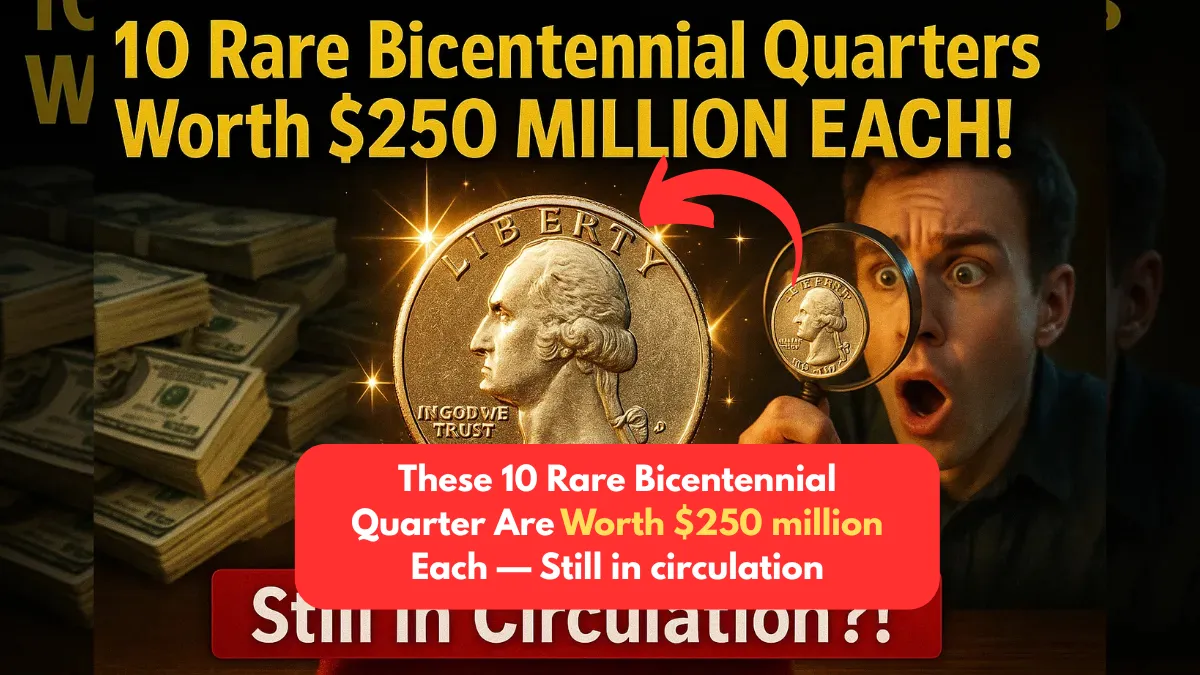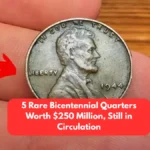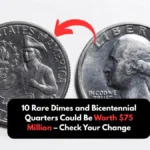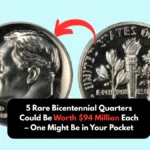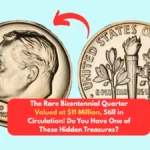Could a Bicentennial Quarter—the same coin you might toss in your spare change jar—be worth a jaw-dropping $250 million? While that may sound unbelievable, it’s true for a handful of rare, extremely valuable coins that were minted to commemorate the 200th anniversary of America’s independence in 1976. These quarters are far from ordinary, and the lucky few who own them could potentially strike it rich.
Could a Bicentennial Quarter Be Worth $250 Million?
It might seem impossible, but some Bicentennial Quarters—those special 1976 coins celebrating America’s 200th birthday—can be worth as much as $250 million. Although most are just regular pocket change, a few rare versions with special traits or minting mistakes have turned into highly valuable treasures. If you happen to own one, it could be worth a fortune beyond your wildest dreams.
While Not Every Bicentennial Quarter Is Worth Millions
Most of these quarters are only worth 25 cents. But some carry unique details that make them exceptionally valuable. These rare examples could still be in circulation today, possibly in a jar of coins, in someone’s wallet, or even in a forgotten drawer. They’re a reminder that even something as ordinary as a quarter can be hiding incredible worth—if you know what to look for.
Here’s Everything You Need to Know About These Incredible Coins
Collectors and everyday people alike are amazed to discover that some quarters from 1976 could be worth millions. What makes these coins so special? From minting mistakes to rare metal compositions, there are several reasons these quarters have captured attention. Let’s take a deeper look into what makes these coins stand out—and how to spot them.
What Is a Bicentennial Quarter?
The U.S. Mint released the Bicentennial Quarter in 1975 and 1976 to honor the 200th anniversary of American independence. Instead of the usual eagle, the reverse shows a colonial drummer beside a torch, with 13 stars above—each one representing one of the original colonies.
The design, crafted by Jack L. Ahr, also includes the dates “1776–1976” as a tribute to the birth of the nation. Two main types were made: the everyday copper-nickel version and a 40% silver version intended for collectors. Although most are common, some contain errors or features that make them incredibly valuable.
Why Are These Quarters Worth $250 Million?
Some of these Bicentennial Quarters fetch such high prices because of extremely rare mistakes or unusual production circumstances. In coin collecting, an error can transform a basic coin into a unique masterpiece.
This rarity, combined with historical significance, makes certain coins worth millions. Simple details, like using the wrong metal or having doubled text, could be what turns one of these coins into a multimillion-dollar treasure.
Factors that Contribute to the Value
Several details can make a Bicentennial Quarter valuable. Minting errors like off-center strikes, double dies, or wrong metal planchets instantly boost a coin’s worth. Some quarters were mistakenly made using silver or even gold. High-grade proof coins, especially those in flawless condition, are another category to look for.
Other features—like a die crack or clipped edge—can make a coin stand out and skyrocket in value. It’s the combination of rarity and condition that really determines a coin’s market price.
Notable Error Types
Error coins come in different forms. A Double Die Obverse shows duplicated images or text. An Off-Center Strike means the design is misaligned. Incorrect Planchets refer to coins made using the wrong metal. Clipped Planchets are quarters that are missing parts due to miscutting. Lastly, Die Cracks are tiny breaks in the die that leave visible lines across the coin’s surface. Each of these rare issues adds a unique value to a quarter.
Top 10 Most Valuable Bicentennial Quarters
While millions of Bicentennial Quarters were made, the most valuable ones are extremely rare and unique. These include minting mistakes, silver content, or other anomalies. Though finding one in your pocket is rare, it’s not impossible. Here are the top 10 most valuable examples, with some fetching prices up to $250 million.
1. 1976-S Silver Proof Bicentennial Quarter (Misstruck)
Made in San Francisco, this quarter was accidentally struck in 90% silver instead of 40%. If preserved well, its value could reach $250 million.
2. 1976 Double Die Obverse Bicentennial Quarter
Minted in Philadelphia, it features doubled text like “LIBERTY” and “IN GOD WE TRUST.” Depending on its condition, it could sell for $50,000 to $250 million.
3. 1976-D Bicentennial Quarter with Off-Center Strike
Produced in Denver, this quarter has a noticeable design misalignment. That mistake could make it worth up to $250 million.
4. 1976-S Bicentennial Quarter with Clipped Planchet
Made in San Francisco, part of the coin is missing due to a cutting error. If in great shape, this can fetch between $100,000 and $250 million.
5. 1976 Bicentennial Quarter Struck on a Foreign Planchet
Created in Philadelphia, this quarter was accidentally struck on a non-U.S. coin blank. Its unique size and composition could raise its value to $250 million.
6. 1976 No Mint Mark Bicentennial Quarter
Also from Philadelphia, these rare quarters lack a mint mark, which is unusual for this year. A good-quality example might sell for up to $100,000.
7. 1976 Bicentennial Quarter Struck with Overlapping Dies
This error, also out of Philadelphia, creates overlapping images on both sides. A flawless version could be valued up to $250 million.
8. 1976-S Silver Proof Quarter with Double Striking
Made in San Francisco, this coin was struck twice, with the second strike slightly off. Perfect examples can range from $100,000 to $250 million.
9. 1976 Bicentennial Quarter with Reverse Die Crack
This Philadelphia quarter features cracks that form noticeable lines or shapes, making it unique. Depending on the visibility of the cracks, its value could go up to $250 million.
10. 1976-D Bicentennial Quarter Struck with Wrong Die
Produced in Denver, this error coin was struck using an incorrect die, making it an exceptionally rare find with a potential value of $250 million.
How to Identify If You Have a Rare Bicentennial Quarter
If you think your quarter might be special, start by checking for key details. Look at the mint mark—“D” for Denver, “S” for San Francisco, or none for Philadelphia. Then, check for errors like doubling, off-center designs, or missing pieces. Test if it’s magnetic; if not, it could be silver. Weigh and measure the coin to ensure it matches or differs from standard specifications. Finally, have it graded by professionals like PCGS or NGC, who can verify its authenticity and determine its potential worth.
Where to Sell or Auction a Rare Bicentennial Quarter
If you believe you’ve found one of these valuable quarters, your next steps are important. Start by getting the coin professionally graded to confirm its value. Then, research similar coins sold at major auction houses like Heritage Auctions. You might also consult a reputable coin dealer to get an expert’s opinion. If your coin is truly exceptional, consider entering it into a rare coin auction, where collectors from around the world compete for such rare finds.
Final Thoughts: A Quarter Worth a Fortune?
It might seem hard to believe, but a simple Bicentennial Quarter could be worth hundreds of millions—if it has the right errors or features. While finding one is rare, it’s not impossible. Keep an eye on your spare change and inspect every coin. That one ordinary-looking quarter might just turn out to be an extraordinary treasure waiting to be discovered.
